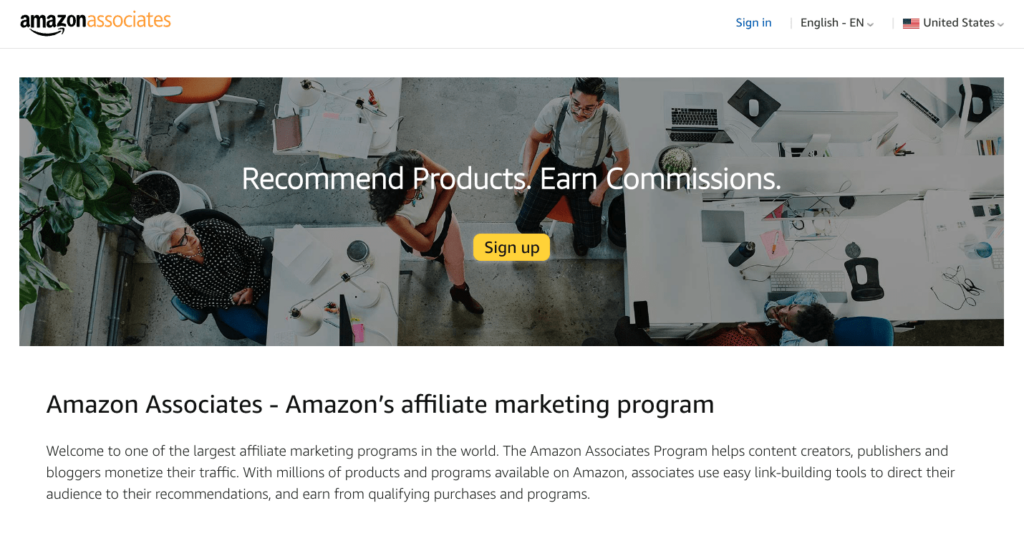Building an Amazon affiliate website is an effective way to enhance your income or launch an online business. The Amazon Associates program is free to join, making it a smart choice for aspiring entrepreneurs. By promoting products through your affiliate links, you can earn commissions on sales generated from your referrals.
With over 900,000 active affiliates, Amazon provides a trusted platform and an extensive product selection to choose from. However, achieving success in this competitive landscape requires dedication and strategic effort.
Key tasks for building a successful Amazon affiliate site include:
- Finding the Right Products: Selecting products that resonate with your audience is crucial for driving sales.
- Creating Engaging Content: Quality content not only attracts visitors but also encourages them to click your affiliate links.
- Optimizing for SEO: Implementing effective SEO strategies will enhance your site’s visibility and increase organic traffic.
This article will delve into the Amazon Associates program, exploring its benefits, potential earnings, and actionable steps to create a successful affiliate site in today’s dynamic online market.
What is Amazon Affiliate Marketing?

Amazon affiliate websites are a popular way to earn money online by encouraging visitors to purchase products through Amazon. Site owners embed Amazon affiliate links within their content, and when a visitor clicks these links and completes a qualifying purchase on Amazon, the site owner earns a commission. This model can be particularly effective for niche sites or blogs that feature product reviews, buying guides, or specific recommendations tailored to their audience’s interests.
One of the key advantages of the Amazon Associates program is its user-friendly setup for creating and integrating affiliate links on your website. Through Amazon’s SiteStripe tool, affiliates can create custom links for individual products or categories. These links can be formatted in various ways, including as simple text links, image banners, or a combination of both, giving website owners flexibility in how they embed these links within their content. For instance, links can be seamlessly included in blog posts, prominently featured in sidebar banners, or placed on dedicated product pages, enhancing visibility and the likelihood of clicks.
Amazon Associates also offers varying commission rates based on product categories, which can impact your earnings. For example, if you’re running a website that focuses on gaming, you might benefit from the 20% commission rate on video game purchases. So, if a visitor buys a $50 game through your link, you would earn a $10 commission. Other categories may offer different rates, and certain items, like subscription-based services, may require additional actions (like a customer signing up for a free trial) to earn a commission. Therefore, reviewing Amazon’s commission structures and requirements must ensure they align with your site’s focus and audience.
Pros of Amazon Affiliate
Creating an Amazon affiliate website is a strategic way to monetize content and build a sustainable online business. Amazon’s affiliate program offers unique advantages that make it highly attractive for content creators and marketers looking to earn passive income. Here are three top benefits of running an Amazon affiliate site:
1. Leverage of a Trusted Brand
Amazon’s globally recognized reputation provides affiliate sites with a built-in credibility boost. Moreover, visitors are often familiar with Amazon’s reliability, which makes them more comfortable purchasing products through your affiliate links. As a result, this trust factor not only encourages conversions but also helps build authority for your site. Additionally, by promoting Amazon products, you are associating your website with a trusted, high-quality retailer. Consequently, this association can enhance your audience’s confidence in your recommendations.
2. Easy to Use with Supportive Tools
The Amazon Associates program is beginner-friendly, making it easy for all website owners, regardless of technical expertise, to start earning revenue. For WordPress users, there are plugins like AAWP (Amazon Affiliate WordPress Plugin) or Amazon’s Link Builder that allow you to integrate and display products on your site effortlessly. These tools make it easy to customize how products appear, helping you create engaging, clickable links that are seamlessly embedded into your content.
Amazon Associates also provides various resources and support options. If you encounter issues, you can reach out to their email support team for guidance. Additionally, you’ll find numerous resources, including comprehensive guides, to help you learn the basics and refine your affiliate strategies. While there are several Amazon affiliate plugins to choose from, selecting one that aligns with your specific content goals can further simplify your workflow and boost your site’s performance.
3. Extensive Product Selection
With over 12 million products on Amazon, you can easily find options to suit any niche. This versatility is ideal for tailoring your recommendations to your audience’s preferences. For instance, a travel blog could feature affiliate links for travel essentials like luggage, while a book review site might highlight the latest novels and non-fiction releases. The key is to understand your audience’s interests and align your product selections accordingly.
Additionally, recommending products you use personally can add a layer of authenticity to your content. By sharing personal insights on products you believe in, you can foster a stronger connection with your audience, increasing the likelihood of engagement and conversions.
Cons of Amazon Affiliate
Building an Amazon affiliate website can be a valuable way to earn extra income, but there are some potential downsides to consider before committing fully to this affiliate partnership. Here are three key challenges Amazon affiliates often face:
1. Low Commission Rates
One notable drawback of Amazon’s affiliate program is its relatively low commission rates compared to other affiliate programs. Amazon’s rates vary by product category, but overall, they tend to be lower than many specialized or high-ticket affiliate programs. As a result, Amazon Associates may be better suited as a supplemental income stream rather than a primary source of income. Additionally, income from affiliate marketing can be unpredictable, as earnings are influenced by factors like traffic volume, conversion rates, and product pricing. This means you might not see immediate results or consistent earnings, especially when starting out.
2. Short 24-Hour Cookie Duration
Amazon’s 24-hour cookie policy can limit your earning potential. You only receive a commission if a visitor clicks your affiliate link and adds an item to their cart within that 24-hour window. This can be challenging, as many readers may need more time to decide on a purchase.
However, if a product is added to the cart within the initial 24 hours, the cookie duration extends to 90 days. This gives you a better chance to earn a commission if the customer completes their purchase during this extended timeframe. While the 90-day window is beneficial, the initial 24-hour limit means that Amazon’s cookie duration is shorter than some other affiliate programs, which can offer cookies lasting up to 30 days.
3. Restrictions on Link Cloaking
Link cloaking, which involves shortening and customizing affiliate links to create a more branded and user-friendly appearance, is not permitted in Amazon’s affiliate program. Specifically, Amazon’s rules mandate that affiliates disclose their links in accordance with FTC guidelines, ensuring transparency with users. Consequently, cloaking links could result in account suspension or even a permanent ban from the Amazon Associates program. Fortunately, Amazon offers a feature that allows affiliates to shorten their links while adhering to its guidelines. As a result, this enables affiliates to create easier-to-share and more user-friendly links without violating any policies.
How Much Can You Make from Amazon Affiliate?

Amazon’s commission rates vary significantly across product categories, meaning your earnings will depend heavily on the specific products you choose to promote. For instance, the Amazon Games category boasts the highest commission rate at 20%, which can be quite lucrative if you target the right audience. In contrast, categories such as Luxury Beauty offer a 10% commission, while others like Televisions, Digital Video Games, and Furniture tend to have lower rates, typically ranging from 1% to 8%. Understanding these commission structures is crucial for estimating your potential earnings and strategizing your promotions effectively.
A survey by Influencer Marketing Hub shows that about 58% of affiliates earn less than $10,000 annually. Only 8% manage to earn over $100,000. Your income potential varies based on several factors. These include the size of your audience, the effectiveness of your marketing efforts, and the time you dedicate to your affiliate business.
As a beginner, you may start with modest earnings. Many affiliates report annual earnings ranging from $100 to $20,000. These figures can vary significantly depending on the number of successful referrals you generate. For instance, promoting a hair dryer might yield a 10% commission, while promoting an Amazon Fire Tablet may earn you only 4%.
Since early earnings can be low while building your Amazon Associate site, it’s smart to have other income sources as a backup. Diversifying your income streams helps mitigate the risks of relying solely on affiliate earnings. This approach allows you the flexibility to grow your Amazon affiliate business over time. As you gain experience and optimize your content and marketing strategies, your earning potential can improve significantly.
Guidelines for Amazon Affiliate Marketing
To become a successful Amazon affiliate, it’s essential to provide value to customers while adhering to the specific criteria laid out by Amazon. Your application will only be reviewed after you’ve made at least three sales within the first 180 days, so understanding what Amazon looks for in affiliates is crucial. Here’s a breakdown of the requirements based on the platform you choose to use for promotion:
1. Website Requirements
If you’re promoting products through a website, Amazon expects your content to be recent, meaning it should have been published within the last 60 days. This ensures that the information is current and relevant for potential buyers. Additionally, your website must offer original content that provides genuine value to visitors, whether through product reviews, tutorials, or engaging blog posts.
2. Mobile App Requirements
Adherence to Amazon’s Mobile Application Policy is mandatory for mobile apps. Your app must be available for download on reputable platforms like Google Play, the Amazon Appstore, or the Apple App Store. It’s also crucial that your app is free to download and does not emulate the Amazon shopping app. This means it should offer unique features or experiences that differentiate it from Amazon’s official app.
3. Social Media Platforms
You can also promote Amazon products on social media platforms like Facebook, X (formerly Twitter), Instagram, YouTube, and TikTok. However, most platforms require at least 500 organic followers to qualify for the affiliate program. This follower count indicates a level of engagement and reach that can help drive sales.
In addition to follower count, your social media accounts must feature original content. Aim to have a significant number of posts—around 10 is a good benchmark—ensuring that your profiles are active and publicly accessible.
4. Compliance with Amazon Policies
Complying with several key requirements is essential to avoid being banned from the affiliate program. Firstly, your website, app, and social media profiles must not contain adult content, promote aggressive behavior, or target children under 13 years old. These guidelines ensure that Amazon affiliates align with the brand’s values and maintain a positive reputation. By adhering to these standards, you can safeguard your affiliate status and contribute to a trustworthy online environment.
Amazon Associate Requirements
Becoming an Amazon Associate is an excellent opportunity to monetize your passion projects or generate extra income through your brand. However, it’s crucial to understand the specific rules and requirements that come with the program to ensure a successful experience. Here’s what you need to know:
Getting Started with Amazon Associates
After signing up for the Amazon affiliate program, you must successfully navigate the application review process. Amazon requires new affiliates to make at least three sales within the first 180 days. If you fail to meet this target, your account will be closed. However, you can reapply after improving your site or marketing strategies.
Once accepted, Amazon’s team will review your website, app, or social media accounts. They ensure you provide fresh, original content that genuinely adds value for their customers. Ethical promotion is a cornerstone of Amazon’s affiliate program. Failing to comply with their guidelines can lead to your account being banned.
When promoting Amazon affiliate links, it’s crucial to follow key guidelines to maintain compliance and audience trust. Start by clearly disclosing earnings. Inform your audience that you may earn commissions from the products you recommend. This transparency builds trust and aligns with Amazon’s policies.
Next, avoid making misleading claims in your promotions. Provide accurate and honest information about the products to help users make informed decisions. Ensure your content adheres to Amazon’s guidelines by avoiding unsuitable or harmful material—steer clear of anything that could be deemed offensive or inappropriate.
When it comes to price references, refrain from mentioning specific prices, as these change frequently. Instead, encourage users to visit Amazon to check current prices. Remember that Amazon prohibits offline promotions for affiliate links. Avoid using them in offline settings, emails, or eBooks; all promotional activities must be conducted online.
Additionally, avoid using link shorteners for Amazon affiliate links. Always use the original links provided by Amazon without modification. Lastly, adhere to Amazon’s branding standards by using only approved branding and trademarks. Any misuse could lead to compliance issues with the affiliate program. By following these practices, you can promote Amazon products effectively and ethically.
How to Build A Successful Amazon Affiliate Website
Creating a profitable Amazon affiliate website requires careful planning and execution. Here are six essential steps to help you establish a solid foundation for your affiliate business:
1. Pick the Right Niche
In today’s competitive online landscape, selecting a specific niche is crucial. A niche website targets a particular audience, allowing you to engage potential loyal followers more effectively. Your niche will guide your content creation and play a significant role in your site’s profitability.
When choosing a niche, consider the following:
- Passion and Knowledge: Select something you understand and enjoy. Your familiarity will enhance your credibility and position you as an expert, making your audience more likely to trust your product recommendations.
- Market Research: Carefully research your target market to understand their behaviors, needs, and preferences. Identify gaps in the market that your site can address.
- Competition Analysis: While popular topics may seem appealing, heavy competition can make it challenging to stand out. Analyze your competitors to find ways to improve your offerings and gain an edge.
2. Select a Web Hosting Provider
Your web hosting provider is the foundation of your website, affecting its speed and availability. A reliable hosting service is vital for a successful Amazon affiliate site. Consider these factors when selecting a host:
- Budget: Determine how much you can spend on hosting. Premium plans may offer advanced features and flexibility, but assess your needs carefully.
- Website Size: Choose a hosting plan based on your site’s requirements. For instance, an online store may need stronger server resources than a simple blog.
- Hosting Features: Look for hosts that provide tools to build and manage your site. For example, Bluehost offers one-click WordPress installation, simplifying the setup process.
- Platform Compatibility: Ensure your hosting plan is optimized for the website platform you plan to use, such as WordPress, to improve performance.

3. Pick a Domain Name
A strong domain name is crucial for your affiliate website as it serves as your site’s address and identity. When choosing a domain, keep these tips in mind:
- Simplicity: Opt for a domain name that is short, easy to remember, and simple to spell. Avoid complex names that might confuse visitors.
- Top-Level Domain (TLD): Choose a TLD that aligns with your site’s purpose. While popular TLDs like .com and .org can enhance credibility, they can also be hard to find. Some hosting providers offer free domains with their plans, saving you the hassle of registering separately.
4. Choose a Website Design
The design of your website plays a crucial role in attracting and retaining users, with visitors forming an impression in just 0.05 seconds. To make a strong impact, focus on creating an appealing and functional layout.
Start with User Experience (UX) by ensuring easy navigation and avoiding cluttered menus and unnecessary widgets. Prioritize only the essential elements to create a seamless experience. Next, aim for a responsive design so your site looks great across all devices, from tablets to smartphones, accommodating various screen sizes.
Page load speed is also essential; even a visually impressive site won’t matter if it loads too slowly, causing users to leave. Opt for website builders like WonderSuite, which offer both visual appeal and user-friendly navigation, to optimize speed and keep visitors engaged.
5. Create Content for Your Amazon Affiliate Website
Content forms the foundation of your affiliate marketing strategy since it’s the primary place to embed affiliate links. To make your content effective and engaging, start by aligning with audience preferences. Create material that matches your target audience’s interests and fits your niche; popular options include product reviews, listicles, tutorials, and comparisons.
Focus on providing value by sharing useful information instead of overly promoting products, as a sales-heavy approach can undermine your credibility and trustworthiness. To maintain audience interest, aim for varied content formats such as blog posts, videos, and infographics, which can enhance engagement and keep readers coming back.
6. Optimize Your Site for SEO
Search engine optimization (SEO) is essential for driving organic traffic to your site. To maximize your SEO efforts, start with keyword research—identify relevant keywords and strategically incorporate them into your content to boost visibility on search engines.
Next, focus on producing valuable content like blog posts and videos that serve your audience’s interests and rank well in search results. Let your keyword research be guided by a thorough understanding of your niche to ensure relevance and resonance with your target audience.
Leverage SEO tools such as Google Analytics, Google Trends, and the Yoast SEO plugin to fine-tune your SEO strategies, track performance, and improve your site’s search engine visibility. Together, these practices can significantly enhance your reach and draw in more visitors.
7. Promote Your Amazon Affiliate Website
In addition to optimizing your site for SEO, actively promote it through various channels:
- Social Media: Leverage platforms like Instagram, Facebook, and TikTok to promote your content and products. Create engaging posts, stories, or reels that showcase products and drive traffic back to your site.
- Email Marketing: Build an email list to inform your audience about new content and promotions. Consider adding an exit-intent popup to capture leads effectively.
What is the Amazon affiliate program?
The Amazon Affiliate Program, commonly known as Amazon Associates, is a well-established affiliate marketing initiative offered by Amazon. This program enables individuals and website owners to earn commissions by promoting and linking to a wide array of products available on the Amazon platform.
How It Works
Participants in the program, referred to as affiliates, can create unique affiliate links for products listed on Amazon. When users click on these links and make purchases, the affiliate earns a percentage of the sale as a commission. This structure allows affiliates to monetize their content by driving traffic to Amazon and facilitating sales.
Popular Among Content Creators
The Amazon Affiliate Program is particularly popular among bloggers, content creators, and website owners seeking to monetize their online presence. The program’s appeal lies in its vast selection of products—ranging from electronics and household items to books and fashion—allowing affiliates to promote items that align with their niche and audience interests.
Benefits of the Program
- Diverse Product Range: Affiliates can promote various products, making it easy to find items that resonate with their audience.
- Trusted Brand: By leveraging the extensive offerings and established trust associated with the Amazon brand, affiliates can increase their credibility and encourage more conversions.
- Monetization Opportunities: The program provides a viable way for individuals to earn income from their content while enjoying the flexibility of promoting products they genuinely like and believe in.
How do you become an Amazon affiliate?
To join the Amazon Associates Program, your website must meet specific qualifications. Before applying, ensure your website aligns with Amazon’s guidelines. Sites that promote illegal activities, violence, or explicit content will be denied access to the program. To ensure your site is eligible, it’s essential to read the Associates Program Policies on Amazon’s website.
Application Process
To join the Amazon affiliate program, ensure your site meets Amazon’s guidelines. Once you’re ready, visit the Amazon Associates homepage and click on ‘Sign Up.’ You will be prompted to log in to an existing Amazon account or create a new one if needed. After logging in, complete your account information, including the name, address, and phone number of the person who will receive payments.
Next, provide details about your website or platform. This could be a website, app, YouTube channel, or any other platform where you plan to promote Amazon products. Then, choose a Store ID that ideally matches your main website’s name. You will also need to provide a brief description of your site’s purpose and the types of Amazon products you plan to promote.
After that, explain your traffic sources. Include information on how you drive visitors to your site, how you plan to generate revenue, the typical methods you use to create affiliate links, and an estimate of your site’s average monthly visitor count. Lastly, select your payment method. You can choose to add credit card and tax information now or at a later time. Once you complete these steps, you will gain access to your Amazon Associates dashboard and be ready to start promoting products.
After setting up your account, you’ll be directed to your Associate homepage. Here, you’ll find a performance dashboard that displays your earnings, summary, and total clicks. This is also where you can search for products to link to in your content.
How to create an Amazon affiliate link
Here’s a straightforward guide to generating and utilizing Amazon affiliate links effectively:
Step-by-Step Guide to Creating Amazon Affiliate Links
1. Log In to Your Amazon Associates Account
Start by logging into your Amazon Associates account. This step ensures that the links you create are tied to your account, allowing for accurate tracking and commission payments.
2. Access Product Linking
Navigate to the “Product Linking” section and click on “Product Links.” This area displays various options for creating links to specific Amazon products.
3. Utilize the Amazon Associates SiteStripe
Creating an Amazon affiliate link is quick and easy using the SiteStripe bar, which appears on product pages. Simply click on the “Text” button in the “Get Link” menu to generate a link. You’ll have the option to create either a short or full-length link, allowing you to choose the format that best suits your promotional needs.
4. Explore Additional Linking Options
Amazon provides tools to enhance your affiliate marketing. Idea Hub helps you find trending products that match your audience’s interests, with filters by category, ratings, or special promotions like Prime Early Access.
You can also link to favorite destinations, such as a product category or a personalized list of recommendations, including videos or blog posts. Linking to search results lets you promote broad selections, which is useful for seasonal items like holiday decor.
Lastly, Amazon lets you link to any page, allowing you to guide users to specific products, lists, or search results tailored to their needs. These tools help you engage audiences and boost earnings.
5. Incorporate Links into Your Content
After creating your affiliate links, strategically place them within your website, YouTube channel, or other promotional materials. Remember, Amazon’s rules prohibit the use of these links in offline promotions, emails, eBooks, or PDFs. Focus on creating quality content that resonates with your audience. Placing your links thoughtfully can encourage clicks and improve your chances of earning commissions.
Final thoughts: How To Build an Amazon Affiliate Website (Step-By-Step Guide)
Establishing an Amazon affiliate account is a strategic way to monetize your content and grow your business. By leveraging Amazon’s extensive product range and reputable brand, you can create an affiliate store that aligns with your niche. Key elements for success include selecting the right niche, producing valuable content, and effectively using Amazon affiliate links to enhance sales.
While the program’s lower commission rates and short cookie duration present some challenges, you can still increase your earnings. Focus on driving traffic to your site and optimizing for search engines. One of the most appealing aspects of this opportunity is that starting your Amazon affiliate marketing journey is completely free. This accessibility makes it an excellent option for anyone eager to establish an affiliate store and boost their income.
Additionally, partnering with a reliable hosting provider like Bluehost ensures your site remains fast and secure. This allows you to concentrate on maximizing conversions without technical concerns.


